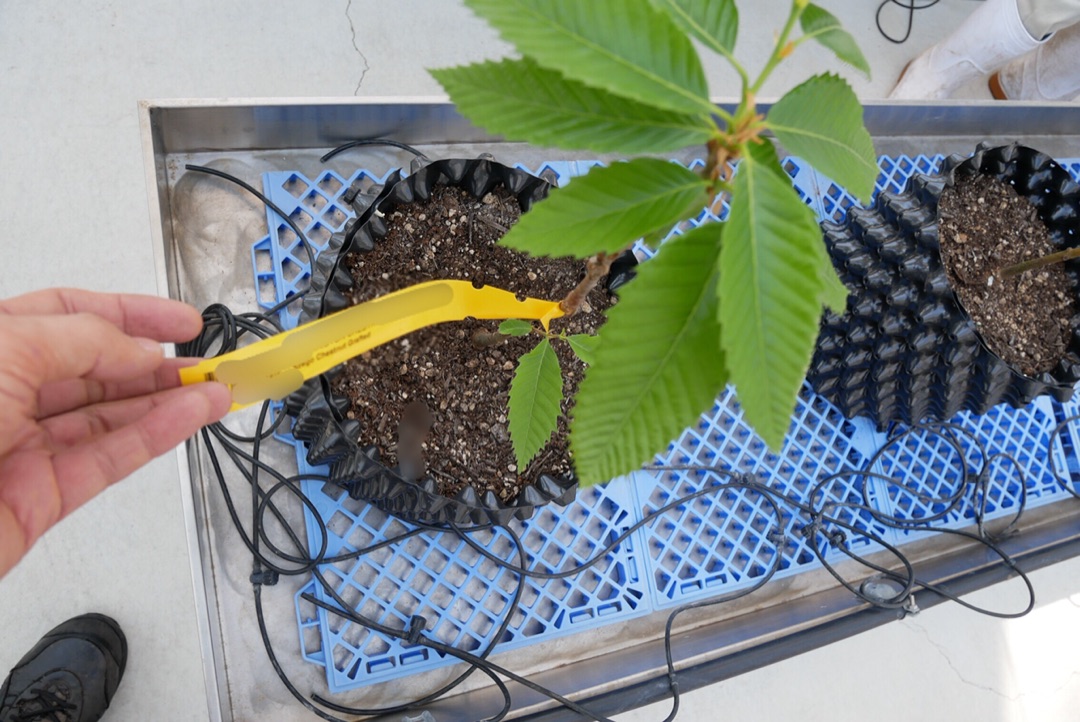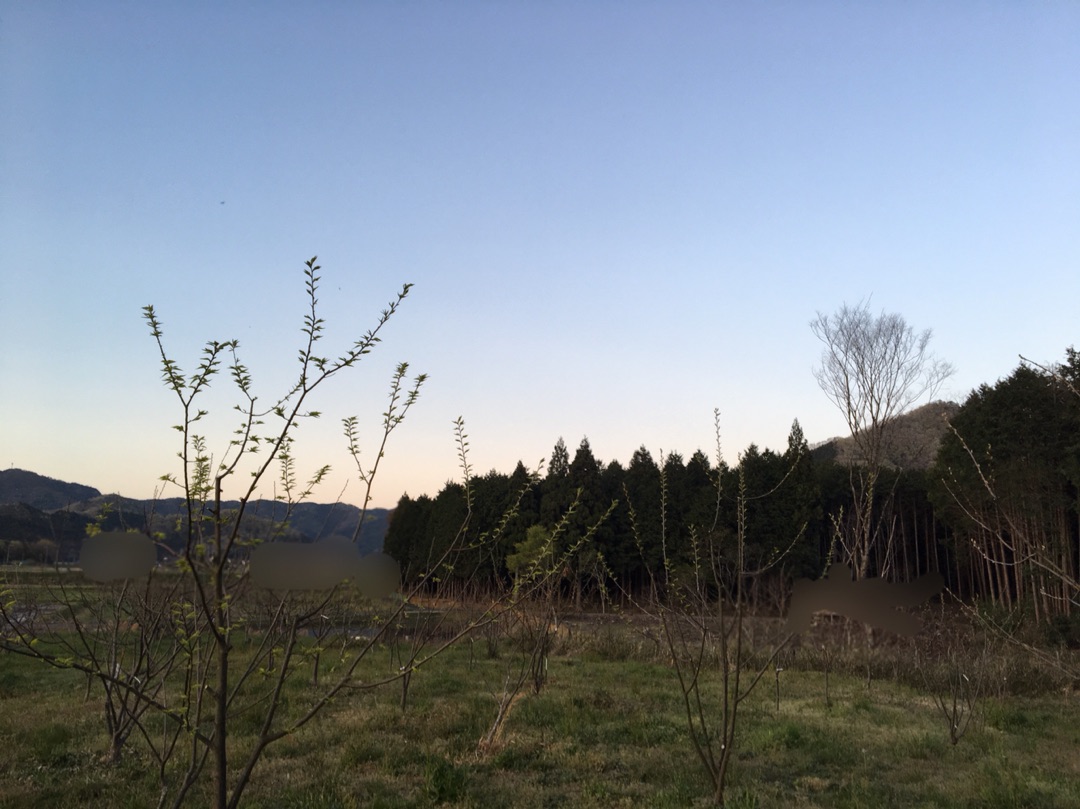猪崎政敏先生の昭和の名著「クリ栽培の理論と実際」には色々なクリ栽培研究のエッセンスが詰まっています。そして、その名著は昭和期の先人達の研究が積み残したクリ栽培の一大テーマにいくつか触れています。
A masterpiece of Dr Masatoshi Izaki in Syowa era, about 40 years ago, ‘Theories and practices of growing chestnut trees (‘Kuri-saibai no riron to zissai’ in Japanese) is filled with the essences of Japanese chestnut researches in Showa Era.
It had touched several issues of chestnut growing unsolved at that time, one of which is late graft failure problem.
そのひとつが「接木不親和」問題。英語ではgraft failure と言います。接木不親和とは接ぎ穂の初期の活着とは区別されるもので、一旦活着した後、時間(2年から30年、時にそれ以上)を経て発育異常もしくは枯死をきたすことです。クリはこの接木不親和が起きやすいのです。病虫害でも不親和でも、とにかくクリは枯れやすいです。特に西日本においては。
Late graft failure is definiitely different from early success of grafting. That is, several to 30 or more years after once grafted trees are established, some of them could wither or die. Grafted chestnut trees are subject to late graft failure. Grafted chestnut trees are prone to wither up from damages of diseases, harmful insects and/or physiological stress, ‘at least as I know’ especially in West Japan.
Photo: Suspected late graft failure in July.
前述の著書で対策としてあげられているのは、
1. 接穂と同品種の実生を台木とする。(共台)
2. 2、3年は苗床で育成して、不親和の症状があるものを除いて移植、植樹する。
3. 挿し木による自根苗の育成。
4. 取り木による自根苗の育成。
の4つ。現在ではもう1つ、組織培養苗が最重要の対策として加わっていますが、この当時はクリの組織培養は不可能なものとして取り組みはほとんどされていません。
On that article Dr Izaki mentioned four measures to take described below against late graft failure.
1. Using the seedlings of the specific same cultivar for rootstocks as the one of grafting scions.
2. After growing the grafted trees in the nursery, removing affected grafted trees with bad signs and transplanting only healthy chestnut trees in the orchard.
3. Using cuttings with their own roots.
4. Using layering with their own roots.
In that Era, because the micropropagation of chestnut was regarded as impossible, he didn’t mention about it.
昭和20年代から40年代にかけて、このクリの深刻な接木不親和問題について近藤亨氏、大山浪雄氏、一井隆夫氏、沢野稔氏、青木秋広氏、松浦永一郎氏、志村勲氏、金戸橘夫氏、安野正純氏、岡田芳麿氏、猪原慥爾氏、そして猪崎政敏氏と数多くの先達研究者が取り組んで多数の論文等の発表をされています。
From 1940s to 1970s a lot of Japanese researchers had coped with the problem of late graft failure and published considerable amount of Japanese papers in Japanese.
しかし昭和50年代以降は日本のクリ栽培が中国と韓国でのクリ生産の台頭とクリタマバチ伝播によって壊滅的減少期を迎え、この接木不親和問題への関心が霧散します。
In spite of the attention until early 1970s, after the outbreak of gall wasp, the growing power of imported chestnuts from China and Korea, and ‘bubble economy’ enthusiasm had gave devastating downsizing impact upon domestic Japanese chestnut farming and industry, interests in late graft failure had disappeared from the chestnut research field in Japan.
(Annotation: The generalized use of methyl-bromide might give the most significant devastating damage to the chestnut industry, since it totally deprives the nice flavor of Japanese chestnut. Chestnut is not a crop but a luxury grocery item tied with its very nice flavor. This is my own theory, that only a few of specialists are aware of. It’s weird that most chestnut professionals are not very interested in eating lovely nice-flavored chestnuts. Anyway, there had been a downsizing change in that period.)
研究者視点から見てみると、日本で取り木自根苗や挿し木自根苗の取り組みが1980年代以降すっかり廃れてしまった原因は、ざっくり要約すると「クリ取り木自根苗・挿し木自根苗の根生育の悪さ」だったと言えます。特に1973年の青木・松浦氏の「クリ台木試験 取木自根樹の生育と収量」(落果試資47-1~2)による「取り木苗は接木苗に生育、収量、根量共に大きく劣る」というデータと、1969年の町田氏、藤井氏による挿し木の発根20%という低い発根成功率のデータが研究者達の研究熱を冷めさせた決め手になっています。
From researchers’ point of view, the reason why they lost interest was, in short, that they observed very weak root system growth in layering/stooling and cuttings. Dr Aoki and Matsuura showed that the chestnut trees derived from layering are inferior to the grafted trees in both growth, production and root amount in 1973. Dr. Machida and Fujii showed low success rate, about 20%, of the rooting of chestnut cuttings in 1969. Those data had made the Japanese researchers lose interest in growing chestnut trees through layering/stooling and cuttings.
いいところまで研究が進んでいたのに、大きな壁にぶち当たってこれは結果出ずダメっぽいからやーめた、とみんなしてこの重要分野の探求をやめてしまったのです。
Although they were aware of the importance of short life problem of grafted chestnut trees, the late graft failure issue, the needs for resistant rootstocks in grafting, chestnut trees on their own roots, and growing chestnut trees from cuttings, many years ago, their successors quit questing whole the issue probably because those measures seemed not to work nicely or the issue seemed
extremely difficult to solve.
extremely difficult to solve.
(次回につづく)
(To be continued)





コメント
SECRET: 0
PASS:
初めまして今年はじめて栗の苗木35本と、自生していた芝栗1本植えて見ました、ブログ見て勉強中です大変さんこうになります今後も宜しくお願いします。植え付けの時切り返した上の方を挿し木したところ、芽がでているのが1本ありました育ってくれるかわかりませんが。
SECRET: 0
PASS:
>jn6yjaさん
和栗栽培は柔らかく肥沃な土地であることが新植成功への近道です。ブログの過去記事が参考になれない幸いです。うまく育つことを祈念します。
クリの挿し木は、地際に切り戻した幼若なひこばえ等しか芽が出ても発根しません。発根には高温多湿にするミスト施設も必要です。また挿し木については後日別途記事にしますので、それをどうぞご覧下さい。